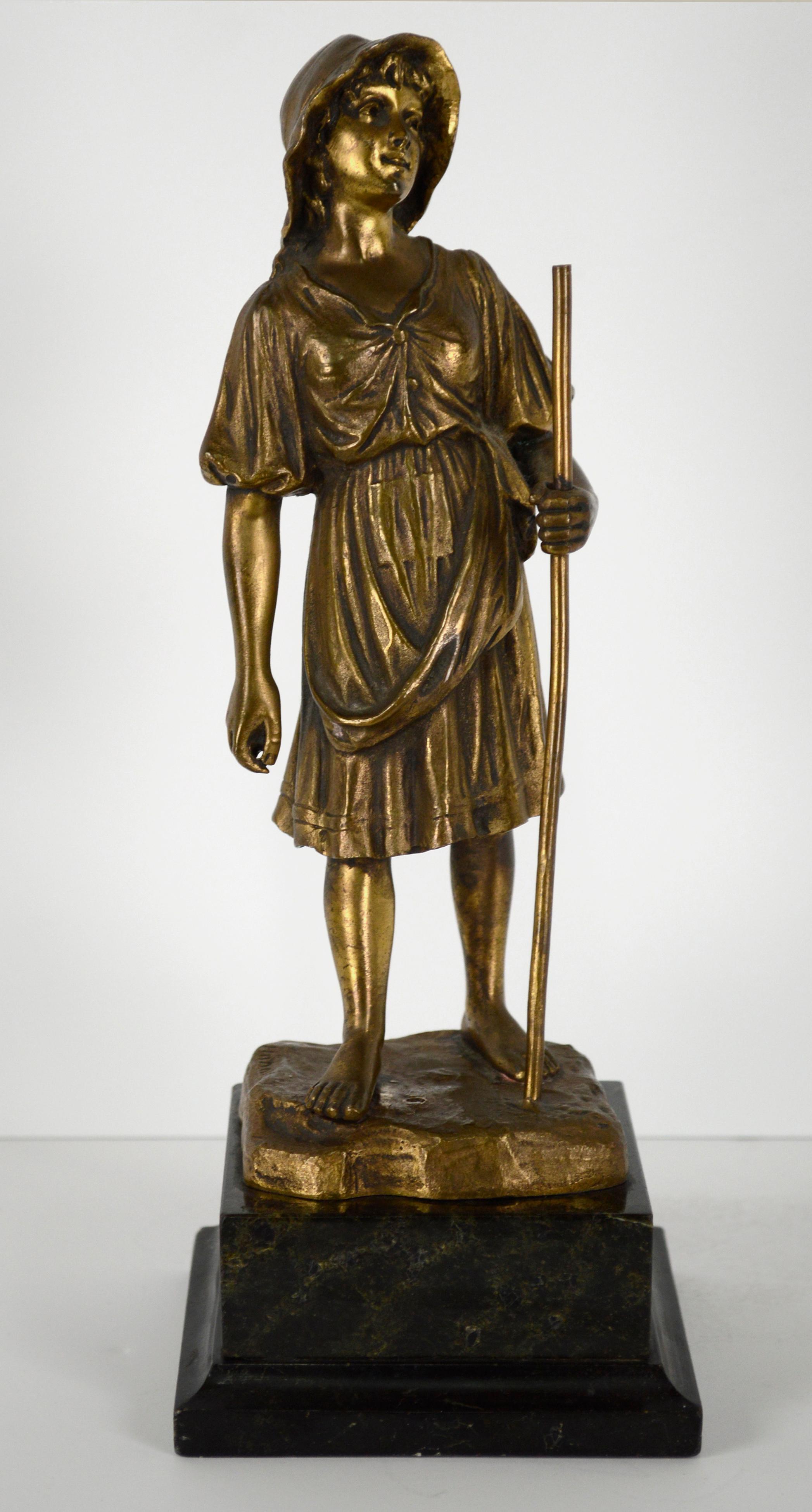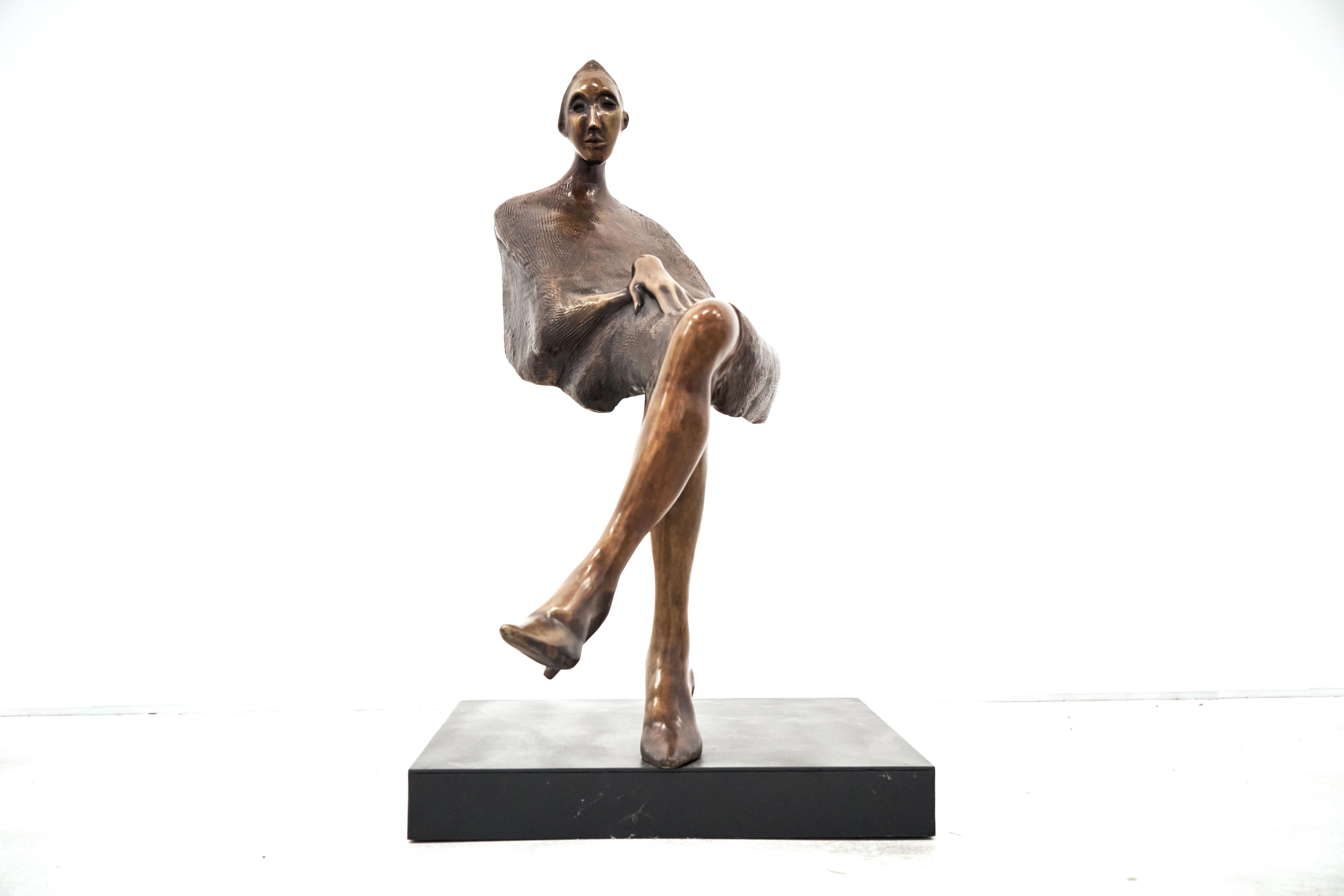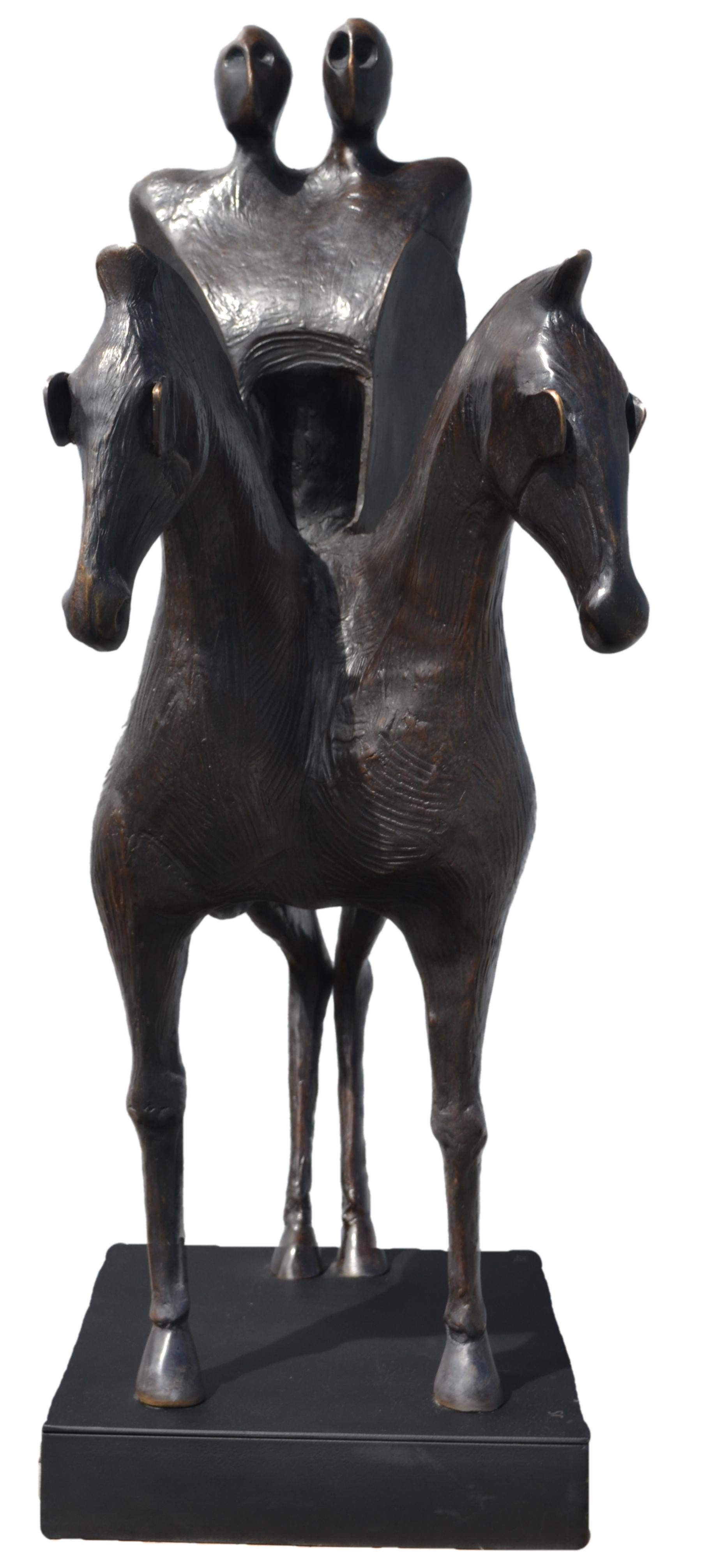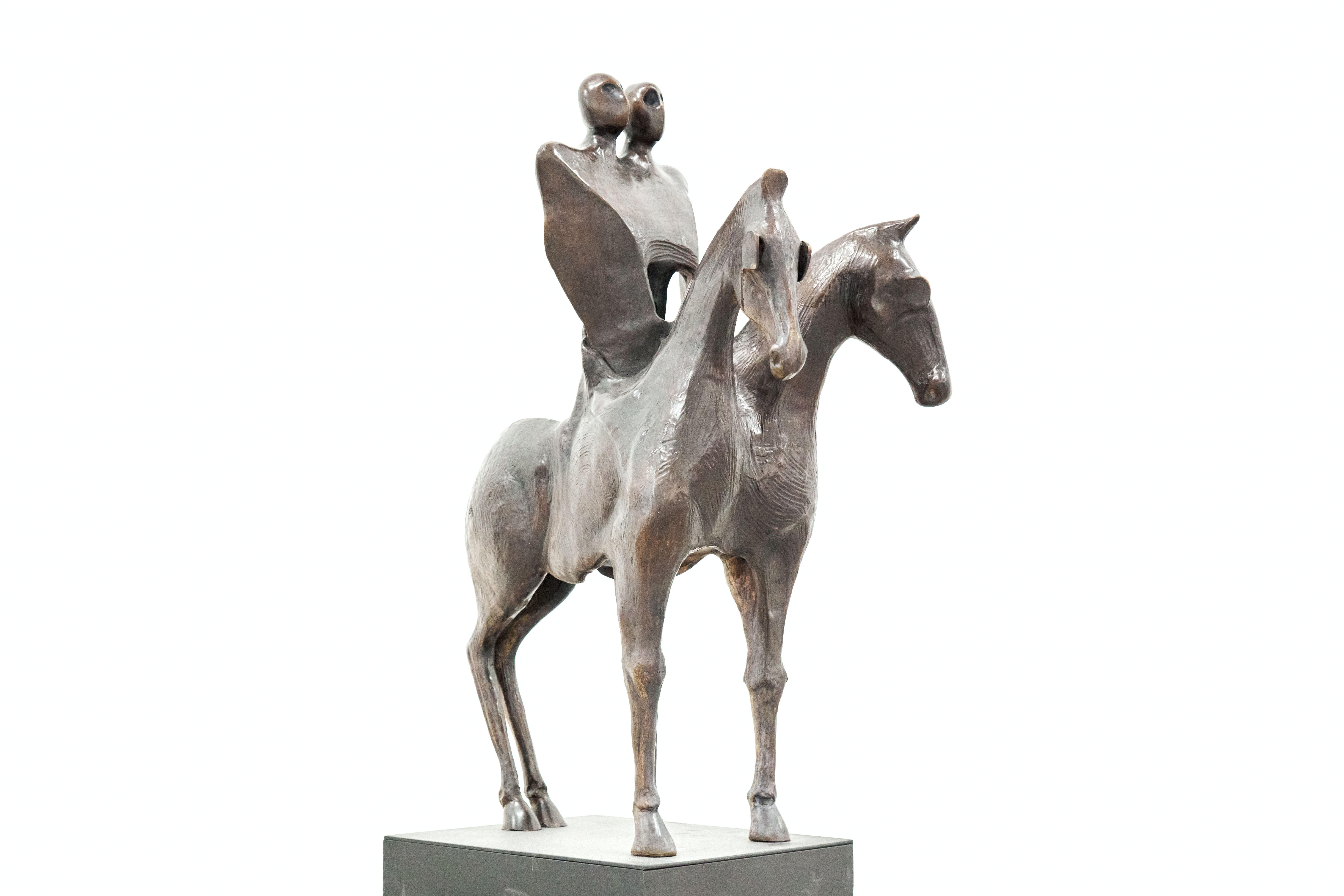Items Similar to Rare Cast Painted Bronze Head Sculpture British Realist Sculptor John Davies
Want more images or videos?
Request additional images or videos from the seller
1 of 17
John DaviesRare Cast Painted Bronze Head Sculpture British Realist Sculptor John Davies1991
1991
About the Item
John Davies (Cheshire, 1946), British sculptor.
Bronze sculpture head
Unique cast (1/1)
This was shown at Marlborough Fine Art (London) Ltd in a show called John Davies New Sculpture.
approximately 13 X 10 X 10
on metal (bronze) base
John Davies started his career in the field of painting, studying at art schools in Hull and Manchester and completing his training at the prestigious Slade School in London between 1968 and 1969. In 1972 he had his first solo exhibition, at the Whitechapel Art Gallery in London, to which he returned three years later to present his sculptures: lifesize polychrome figures with a “realistic” appearance (fitted with fibreglass eyes and wearing outdoor or work clothes and shoes), generally arranged in pairs or groups, accompanied by a series of large heads with masks and other items that distorted their features. The dramatic theatrical effect of the installation surprised the public and the London critics, who discovered the work of a realistic figurative sculptor who kept his distance from the abstract modes that predominated in British sculpture at the time. His first works were inspired by Surrealism. In the early 1970´s he moved to a more realist style. He also worked in painting and drawing. During the eighties his work gradually abandoned the more or less illusionist references to reality and he began to paint his sculptures grey, avoiding giving them a “natural” appearance and even incorporating drawing in them. During this period he worked on several series of small or life-size sculptures, showing self absorbed nude figures climbing ropes or steps or hanging on trapezes as if they were circus acrobats. Among his best known works are the series of heads made in the eighties and nineties on various scales, from life-size and polychromed painted small items to cyclopean heads of more than 2 meters high. This series reveals how Davies handles the scale and texture devices with technical ease. His work can be related to other contemporary figurative painters and sculptors who deal with the representation of man Francis Bacon, Lucian Freud, Alberto Giacometti, Edward Kienholz, George Segal, Duane Hanson and in a closer context to Antonio López, among others- Davies still has a singular place in the British sculpture because of his personal vision of the human representation. Davies’s sculptural work concentrates on the human figure, although he has also worked intensely in the field of drawing. In 1970 he won a Sainsbury Award, and his sculptures and drawings have been included in numerous group exhibitions in Europe and the United States. He had a major solo exhibition was at the Whitworth Art Gallery in Manchester in 1996. He currently lives and works in London.
- Creator:John Davies (1946, British)
- Creation Year:1991
- Dimensions:Height: 13 in (33.02 cm)Width: 10 in (25.4 cm)Depth: 10 in (25.4 cm)
- Medium:
- Period:
- Condition:
- Gallery Location:Surfside, FL
- Reference Number:1stDibs: LU38213880592
About the Seller
4.9
Platinum Seller
These expertly vetted sellers are 1stDibs' most experienced sellers and are rated highest by our customers.
Established in 1995
1stDibs seller since 2014
1,565 sales on 1stDibs
Typical response time: 1 hour
- ShippingRetrieving quote...Ships From: Surfside, FL
- Return PolicyA return for this item may be initiated within 3 days of delivery.
More From This SellerView All
- French Pop Art Heavy Bronze Sculpture Chess Game Gambit Arman AccumulationBy ArmanLocated in Surfside, FLArman, French American (1928-2005) Gambit (Chess pieces) Cast Bronze Sculpture with patina Incised signature near lower edge, 48/70 with impressed "Bronze Romain & Fils" foundry ma...Category
Early 2000s Abstract Figurative Sculptures
MaterialsBronze
- Large Chaim Gross Mid Century Mod Bronze Sculpture Circus Acrobats WPA ArtistBy Chaim GrossLocated in Surfside, FLChaim Gross (American, 1904-1991) Patinated cast bronze sculpture, Three Acrobats, signed mounted on black marble plinth 24.5"h x 14"w x 7"d (bronze alone) Chaim Gross (March 17, 1904 – May 5, 1991) was an American modernist sculptor and educator. Gross was born to a Jewish family in Austrian Galicia, in the village of Wolowa (now known as Mezhgorye, Ukraine), in the Carpathian Mountains. In 1911, his family moved to Kolomyia (which was annexed into the Ukrainian USSR in 1939 and became part of newly independent Ukraine in 1991). When World War I ended, Gross and brother Avrom-Leib went to Budapest to join their older siblings Sarah and Pinkas. Gross applied to and was accepted by the art academy in Budapest and studied under the painter Béla Uitz, though within a year a new regime under Miklos Horthy took over and attempted to expel all Jews and foreigners from the country. After being deported from Hungary, Gross began art studies at the Kunstgewerbeschule in Vienna, Austria shortly before immigrating to the United States in 1921. Gross's studies continued in the United States at the Beaux-Arts Institute of Design, where he studied with Elie Nadelman and others, and at the Art Students League of New York, with Robert Laurent. He also attended the Educational Alliance Art School, studying under Abbo Ostrowsky, at the same time as Moses Soyer and Peter Blume. In 1926 Gross began teaching at The Educational Alliance, and continued teaching there for the next 50 years. Louise Nevelson was among his students at the Alliance (in 1934), during the time she was transitioning from painting to sculpture. In the late 1920s and early 1930s he exhibited at the Salons of America exhibitions at the Anderson Galleries and, beginning in 1928, at the Whitney Studio Club. In 1929, Gross experimented with printmaking, and created an important group of 15 linocuts and lithographs of landscapes, New York City streets and parks, women in interiors, the circus, and vaudeville. The entire suite is now in the collection of the Philadelphia Museum of Art. Gross returned to the medium of printmaking in the 1960s, and produced approximately 200 works in the medium over the next two decades. For more than sixty years Chaim Gross's art has expressed optimistic, affirming themes, Judaica, balancing acrobats, cyclists, trapeze artists and mothers and children convey joyfulness, modernism, exuberance, love, and intimacy. This aspect of his work remained consistent with his Jewish Hasidic heritage, which teaches that only in his childlike happiness is man nearest to God. In March 1932 Gross had his first solo exhibition at Gallery 144 in New York City. For a short time they represented Gross, as well as his friends Milton Avery, Moses Soyer, Ahron Ben-Shmuel and others. Gross was primarily a practitioner of the direct carving method, with the majority of his work being carved from wood. Other direct carvers in early 20th-century American art include William Zorach, Jose de Creeft, and Robert Laurent. Works by Chaim Gross can be found in major museums and private collections throughout the United States, with substantial holdings (27 sculptures) at the Hirshhorn Museum and Sculpture Garden. A key work from this era, now at the Smithsonian American Art Museum, is the 1932 birds-eye maple Acrobatic Performers, which is also only one and one quarter inch thick. In 1933 Gross joined the government's PWAP (Public Works of Art Project), which transitioned into the WPA (Works Progress Administration), which Gross worked for later in the 1930s. Under these programs Gross taught and demonstrated art, made sculptures that were placed in schools and public colleges, made work for Federal buildings including the Federal Trade Commission Building, and for the France Overseas and Finnish Buildings at the 1939 New York World's Fair. Gross was also recognized during these years with a silver medal at the Exposition universelle de 1937 in Paris, and in 1942, with a purchase prize at the Metropolitan Museum of Art's "Artists for Victory" exhibition for his wood sculpture of famed circus performer Lillian Leitzel. In 1949 Gross sketched Chaim Weizmann, President of Israel, at several functions in New York City where Weizmann was speaking, Gross completed the bust in bronze later that year. Gross returned to Israel for three months in 1951 (the second of many trips there in the postwar years) to paint a series of 40 watercolors of life in various cities. This series was exhibited at the Jewish Museum (Manhattan) in 1953. In the 1950s Gross began to make more bronze sculptures alongside his wood and stone pieces, and in 1957 and 1959 he traveled to Rome to work with famed bronze foundries including the Nicci foundry. At the end of the decade Gross was working primarily in bronze which allowed him to create open forms, large-scale works and of course, multiple casts. Gross's large-scale bronze The Family, donated to New York City in 1991 in honor of Mayor Ed Koch, and installed at the Bleecker Street Park at 11th street, is now a fixture of Greenwich Village. In 1959, a survey of Gross's sculpture in wood, stone, and bronze was featured in the exhibit Four American Expressionists curated by Lloyd Goodrich at the Whitney Museum of American Art, with work by Abraham Rattner, Doris Caesar, and Karl Knaths. In 1976, a selection from Gross's important collection of historic African sculpture, formed since the late 1930s, was exhibited at the Worcester Art Museum in the show The Sculptor's Eye: The African Art Collection of Mr. and Mrs. Chaim Gross. Gross was elected into the National Academy of Design as an Associate member, and became a full Academician in 1981. In 1984, he was inducted into the American Academy of Arts and Letters, with Jacob Lawrence and Lukas Foss. In the fall of 1991, Allen Ginsberg gave an important tribute to Gross at the American Academy of Arts and Letters, which is published in their Proceedings. In 1994, Forum Gallery, which now represents the Chaim Gross estate, held a memorial exhibition featuring a sixty-year survey of Gross's work. Gross was a professor of printmaking and sculpture at both the Educational Alliance and the New School for Social Research in New York City, as well as at the Brooklyn Museum Art School, the MoMA art school, the Art Student's League and the New Art School (which Gross ran briefly with Alexander Dobkin...Category
Mid-20th Century American Modern Figurative Sculptures
MaterialsMarble, Bronze
- Bronze Architectural Model Sculpture Tempio Bretton Architecture MaquetteLocated in Surfside, FLTEMPIO BRETTON: from the catalogue MONUMENTA, 19th International Sculpture Biennale, Antwerp, Belgium. Tempio Bretton was created in homage to the celebrated English landscapist Capability Brown for the occasion of an exhibition at Bretton Hall in the Yorkshire Sculpture Park , a park in the style of the great master of English garden design. The inclusion in the English garden of a temple ruin, or "eye-catcher," (architectural folly) was used to draw the eye and mind to a focus in time and space, present the beholder with an immediate relationship to an historic past made new within his or her own surroundings, and create a depth of space never before seen in garden design. I took the idea of the temple ruin eye-catcher and reduced it to a scale at the point where architecture and sculpture merged. Tempio Bretton is not capacious enough to walk into, yet it is considerably larger than a man. One view of it presents a knot of golden columns clustered together, topped by a dome shape. The only clue from this side to the temple's non-conformity to historic principle is a sharp notch cut into the square base. Viewed from the opposite side, the cluster of columns capped by an angular top opens up as if to welcome someone in, yet the mysterious core is still impenetrable. These contradictions articulate a confrontation between past and present, and an exciting truth. The past is always at the heart of our constructions in the present. Walter Dusenbery...Category
20th Century American Modern Abstract Sculptures
MaterialsBronze
- Cast Bronze Organic Husk Wall Mounted Abstract Textured Sculpture Seena DonnesonBy Seena DonnesonLocated in Surfside, FLThis is an abstract Flora based hand made, cast sculpture done by Seena Donneson an acclaimed woman artist. A textured abstract bronze with deep, rich patina; The sculpture is signed...Category
21st Century and Contemporary Modern Abstract Sculptures
MaterialsBronze
- Russian French Judaica Jewish Shtetl Wedding Klezmer Musician Bronze SculptureBy Mane KatzLocated in Surfside, FLBronze Double Bass Player Klezmer Musician Sculpture signed Mane-Katz at base. Numbered 8/8. -Katz (1894-1962) was a Litvak painter born in Ukraine best known for his depictions of the Jewish shtetl in Eastern Europe. Emmanuel Mané-Katz (Hebrew:מאנה כץ), born Mane Leyzerovich Kats (1894–1962), was a Litvak painter born in Kremenchuk, Ukraine, best known for his depictions of the Jewish shtetl in Eastern Europe. Particularly music figures and Jewish wedding scenes. Mane-Katz moved to Paris at the age of 19 to study art, although his father wanted him to be a rabbi. During the First World War he returned to Russia, at first working and exhibiting in Petrograd; following the October revolution, he traveled back to Kremenchuk, where he taught art. In 1921, due to the ongoing fighting in his hometown during the civil war, he moved once again to Paris. There he became friends with Pablo Picasso and other important French artists, and was affiliated with the art movement known as the School of Paris; together with other outstanding Jewish artists of that milieu, he is sometimes considered to be part of a group referred to specifically as the Jewish School of Paris. Includes Russian, Ukrainian and Polish painters Jankel Adler, Arbit Blatas, Marc Chagall, Jacques Chapiro, Michel Kikoine, Pinchus Kremegne, Sigmund Menkes, Jules Pascin, Issachar Ryback, Jacques Lipchitz,Chana Orloff, and Ossip Zadkine. Ecole de Paris In 1931, Mane-Katz's painting The Wailing Wall was awarded a gold medal at the Paris World's Fair. Early on, his style was classical and somber, but his palette changed in later years to bright, primary colors, with an emphasis on Jewish themes. His oils feature Judaic Hasidic characters, rabbis, Jewish musicians, beggars, yeshiva students and scenes from the East European shtetl made famous in the west by Sholem Aleichem and Tevye. Mane-Katz made his first trip to Mandate Palestine in 1928, and thereafter visited the country annually. He said his actual home was Paris, but his spiritual home was Eretz Yisrael, the Land of Israel. In 1939, as World War II was breaking out, he was drafted by the French and then was taken prisoner by the Germans. He escaped and went to the United States and remained there until 1945, exhibiting his paintings at Katia Granoff Gallery and Wildenstein Gallery. After the war, he returned to Paris where he had exhibited in the Salons. In Paris to the end of his career, he worked happily, painting hundreds of portraits of rabbis...Category
1960s Modern Figurative Sculptures
MaterialsBronze
- Cast Bronze Organic Husk Wall Mounted Abstract Textured Sculpture Seena DonnesonBy Seena DonnesonLocated in Surfside, FLThis is an abstract Flora based hand made, cast sculpture done by Seena Donneson an acclaimed woman artist. A textured abstract bronze with deep, rich patina; The sculpture is signed...Category
21st Century and Contemporary Modern Abstract Sculptures
MaterialsBronze
You May Also Like
- Show of InterestBy Brad RudeLocated in Denver, COArtist Brad Rude was born in Montana and has lived in Walla Walla, Washington most of his life. His journeys through his grandfather's folk art studio left...Category
2010s American Modern Figurative Sculptures
MaterialsEnamel, Bronze
- Early 20th Century Bronze Figure Sculpture, Shepherd Girl with Staff StatueLocated in Soquel, CAWonderful miniature bronze cast figurative sculpture of a young barefoot shepherd girl holding a staff by R. Hobold (German, 19th c). The girl is dressed in a flowing peasant dress a...Category
Early 20th Century Jugendstil Figurative Sculptures
MaterialsMarble, Bronze
- Jorge Seguí, Ilusion silla, 2000, Bronze, Edition of 7, 78 x 90 x 33 cmBy Jorge SeguíLocated in Miami, FLJorge Seguí Ilusion silla, 2000 Bronze, Edition of 7 78 x 90 x 33 cm 30.7 x 35.4 x 12.9 in. Signed and Numbered. Jorge Seguí b. 1945, Argentina. He atte...Category
Early 2000s Contemporary Figurative Sculptures
MaterialsBronze
- Jorge Seguí, Falsos Heroes en Caballos Míticos, Bronze, Edition 1/7, 2010-2013By Jorge SeguíLocated in Miami, FLJorge Seguí Falsos Heroes en Caballos Míticos, 2010-13 Bronze, Edition 1/7 110 x 71 x 70 cm 43.3 x 27.9 x 27.5 in. Signed and Numbered. Jorge Seguí b. 19...Category
2010s Contemporary Figurative Sculptures
MaterialsBronze
- Jorge Seguí, Falsos Heroes en Caballos Míticos, 2010-2013, Bronze, Edition 1/7By Jorge SeguíLocated in Miami, FLJorge Seguí Falsos Heroes en Caballos Míticos, 2010-2013 Bronze, Edition 1/7 110 x 71 x 70 cm 43.3 x 27.9 x 27.5 in. Signed and Numbered. Jorge Seguí b...Category
2010s Contemporary Figurative Sculptures
MaterialsBronze
- Jorge Segui Magic Woman, 2019 Bronze. 1/3 APBy Jorge SeguíLocated in Miami, FLJorge Segui Magic Woman, 2019 Bronze. 1/3 AP 83.8 x 91.4 x 59.6 cm 33 x 36 x 23.5 in. Signed and Numbered. Jorge Seguí b. 1945, Argentina. He attended th...Category
2010s Contemporary Figurative Sculptures
MaterialsBronze
Recently Viewed
View AllMore Ways To Browse
Large Head
Sculpture Head
Bronze Sculptor
Art Sculpture Head
Bronze Head
Study Sculpture Head
Head Cast
Vintage Head Sculpture
1970s Clothes
Large Head Sculpture
Bronze Head Sculptures
Head On Base Sculpture
British Bronze
Small Head Sculpture
Cast Sculpture Head
1970s Clothes Vintage
European Vintage Clothes
Head Metal Sculpture




